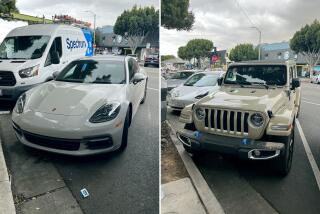New Cadillac designs steer clear of the retro look
- Share via
Cadillac celebrated its 100th birthday this year but is following a design philosophy that focuses on the road ahead with only an occasional glance in the rearview mirror.
Starting with the 1999 Evoq concept, the luxury division of General Motors Corp. adopted a bolder look highlighted by sharp edges and creases.
Those touches carry over to the CTS sedan and the SRX, a sport utility vehicle that Cadillac plans to unveil next month at the North American International Auto Show in Detroit.
All three share design features from Cadillac’s past, such as an egg-crate grille and vertical taillights, but designer John “Kip” Wasenko with General Motors describes such cues as “heritage, not retro.”
Contemporary cars such as Volkswagen’s New Beetle and Ford Motor Co.’s Thunderbird often are labeled retro because they rely heavily on their original designs.
Wasenko says Cadillac rejected retro design as a short-term trend and one that doesn’t fit with plans to expand sales outside the United States.
“Europeans say this fascination with retro design seems to be an American thing. Mercedes-Benz and BMW pay a lot of attention to their heritage, but they are always advancing their design,” he said. “There’s a fine line between retro and heritage, and heritage is more looking toward the future. Heritage is where you’ve come from, your lineage. Retro is a very literal interpretation of your past.
“We want to be respected for what we do in the future, not just remembered for what we did in the past.”
Jerry Hirshberg, retired head of Nissan Design International in La Jolla, praises Cadillac for its refreshing look, but he doubts whether most consumers will connect subtle styling touches to past Cadillacs best known for size and fins.
“It’s a healthy change for Cadillac. But if you had shown [the Evoq] to a group of people, would they have said, ‘Oh, that’s a Cadillac’ because of the grille and taillights?
“I’m not sure it’s arousing anyone else. A lot of people don’t get excited about grille texture,” Hirshberg said.
Wasenko led the team that designed the Evoq, which launched styling that Cadillac dubbed “art and science” and that he calls “contemporary industrial design,” an edgy look seen on the CTS and other Cadillacs in the pipeline.
“We want to establish a bold design statement that’s more recognizable -- establish more continuity in our lineup,” Wasenko said while in Chicago for a recent meeting of the Midwest Automotive Media Assn. “All [of the new models] have their individual personality, but they have a consistent theme we think is essential.”
“Unfortunately, in the past we didn’t have that,” he added, citing the Cadillac Catera. The car, sold from 1997 to 2001, was based on the European Opel Omega and looked like an adopted member of the Cadillac family.
Wasenko, design director of GM’s new performance division, said the 2004 XLR roadster and the 2005 STS sedan, which has not been shown to the public, would carry a design theme similar to those of the CTS and SRX.
“It will not be the same,” he said, “but you’ll see a further evolution and refinement of the current design philosophy.”
*
Rick Popely writes about the auto industry for the Chicago Tribune, a Times sister paper. E-mail: rpopely@tribune.com.




